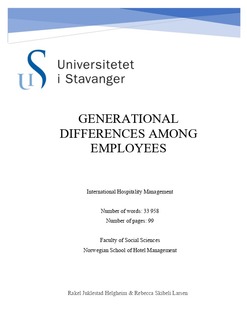| dc.description.abstract | This thesis is a result of personal interest related to the changes in the workforce related to age and demands in Norway. As we are born in different generations, but are at the same stage at life, the threshold to the working life, we wanted to explore the possible challenges that awaits us after we have delivered this thesis.
The workforce appears to change every year, and by 2020, Generation Z will make up about 20% of it (Robert Half, 2019), and therefore we wanted to study this arising generation. We chose to compare it to the parent generation, Generation X. The aim of our study provide an elaboration of the differences and similarities, both within and between the generations. Stewart, Oliver, Cravens and Oishi (2017, p. 46) reported that Generation X have used several years to work their way up the career ladder, and therefore they feel like “old souls” in the workforce as the younger start entering the organizations. However, Chillakuri and Mahanandia (2018, p. 34) claimed that Generation Z can bring potential changes to the organizational landscape. It is therefore important that generational differences are welcomed and not overlooked.
We used a descriptive qualitative method, and the data was collected by using CurroCus group interviews (faster focus groups). We had seven groups, a total of 36 participants, with 14 from generation X and 22 from Generation Z. The participants were asked to discuss challenges, advantages, motivation factors, authority, flexibility, communication, loyalty, technology, teamwork and learning. All of the interviews were coded. The raw data was analyzed through an approach to grounded theory, where we ended up with 6 A-level categories for both of the generations, which represent our main findings.
We discovered that every employee has to be viewed as an individual with its own preferences, and these might not be related to age. In relation to differences within the generations we could not find anything major, but we did however find differences between the generations. These differences were related to the Law of Jante, and the upbringing of the generations. Differences were also present in the usage of technology, where the younger seemed more dependent on it, as well as more addicted it. However, both generations expressed a fear of being replaced by technological devices. | nb_NO |
